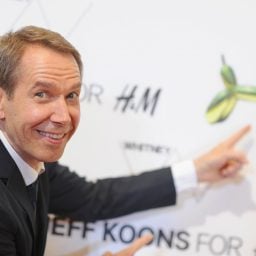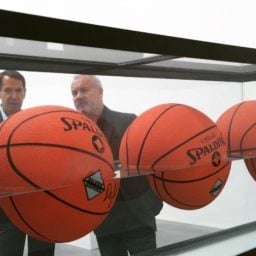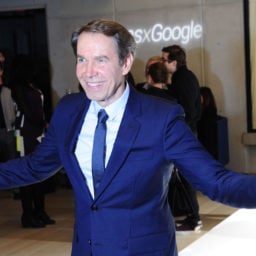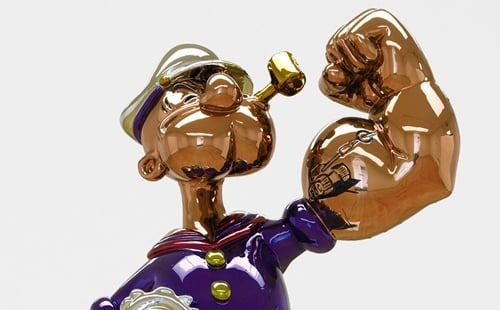

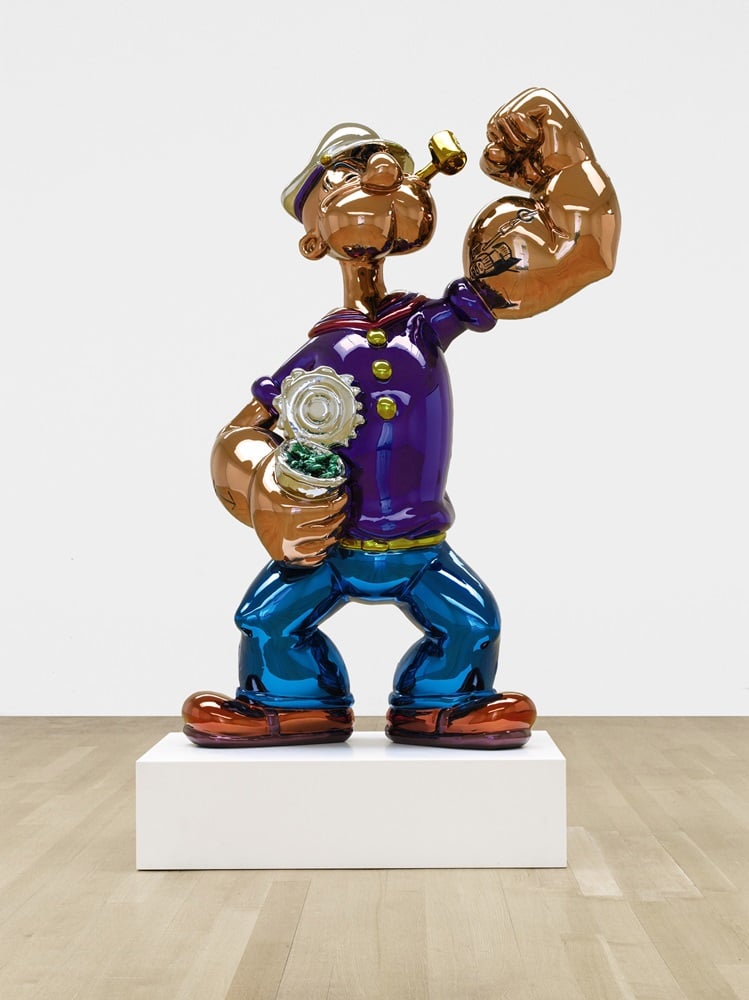
Casino Mogul Steve Wynn bet big on Jeff Koons’s Popeye at Sotheby’s (2009-2011) last month, paying $28.2 million.
© 2014 Jeff Koons.
Fever pitch doesn’t quite describe the current hype surrounding Jeff Koons and the market for his works. Concurrent shows at powerhouse galleries David Zwirner and Gagosian last spring were followed by a fresh string of auction records at recent sales. The $58.4 million price achieved this past fall for the giant orange Balloon Dog at Christie’s New York made Koons the most expensive living artist at auction, and (not surprisingly) he tops artnet’s list of the most expensive American artists (or any artist for that matter, he outstrips even Gerhard Richter).
Alex Rotter, Sotheby’s worldwide head of contemporary art says it speaks volumes about the intensity of demand that Koons’s work was featured on the respective covers of both Sotheby’s and Christie’s evening contemporary sale catalogues last month. Popeye (2009–2011), a six-and-a-half-foot tall gleaming depiction of the swarthy cartoon sailor, sold for $28.2 million on a winning bet by Las Vegas casino mogul Steve Wynn, who has put the work on display in his home town.
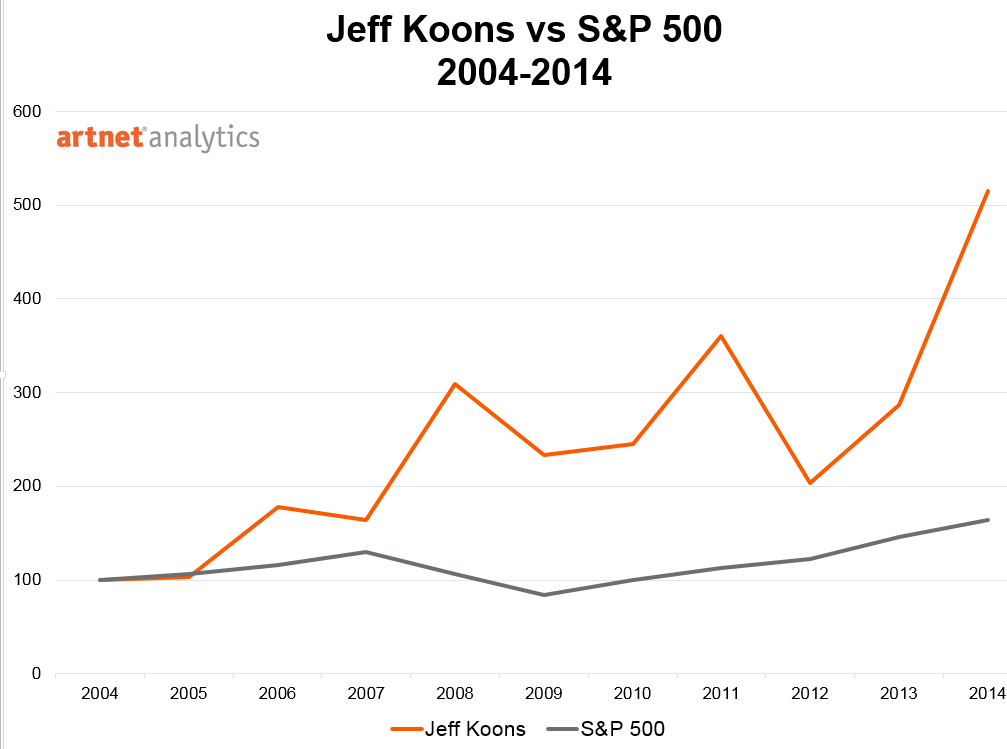
Auction price performance of Jeff Koons works vs S&P 500.
Source: artnet Analytics.
With the Whitney Museum less than two weeks away from opening the first major retrospective of Koons’s work, avid fans, skeptics and outright haters are bracing for the inevitable blitz. The Koons show, which will be the last one at the museum’s uptown building before it moves into its new digs in the Meatpacking District, will be a building-wide takeover of all things Koons; from basketballs suspended in aquarium tanks and vitrine-encased Hoover vacuums to inflatable seals in trash cans, shiny Jim Beam trains, and, of course, Michael Jackson with Bubbles. That sculpture floated to $5.6 million at Sotheby’s New York in 2001, right around the start of the contemporary market’s first major surge.
Coinciding with the Whitney, the artist’s massive 37-foot-high sculpture Split Rocker, a planted form comprised of more than 50,000 flowering plants, will be unveiled in Rockefeller Center and remain there during the summer months. (In a decidedly more low-brow, mass-market vein, Koons has also joined forces with fashion retailer H&M to produce a black leather bag sporting an image of the artist’s iconic balloon dog. The store will also feature an enormous image of a yellow balloon dog on the exterior of its Midtown store). And readers of Vanity Fair will get more than an eyeful of him: the latest issue shows a full-length body shot of him working out in the buff.
What is perhaps most surprising in examining the auction data is how dominant Koons sculptures are at auction compared with his painting. On average only 1 or 2 paintings come to auction each year, according to artnet analytics. The largest number in a single year was five, which occurred in both 2005 and 2007. In comparison, starting around 2000, at least a dozen Koons sculptures appeared at auction each year, a number that hit 43 works in 2005 (for total sales value of $15.3 million), and a whopping 73 sculptures in 2008 (for total sales value of $88.8 million). In 2014 to date, 30 sculptures have appeared at auction, racking up $112.8 million in sales, with pieces averaging about $3.7 million each, according to artnet analytics.
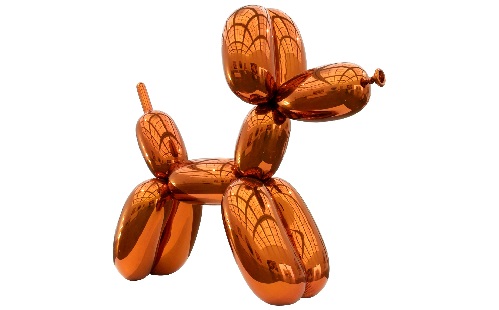
Koons’s Balloon Dog (Orange) sold for $58 million at Christie’s this past November, the most expensive work by a living artist ever sold at auction.
However, the average price per painting tends to be higher when compared with the sculptures, which makes sense considering that many of the sculptures, both large and small, are executed in editions. The sculptures tend to average in the mid-six figures, while the paintings more typically fall in the $1 million to $3 million range.
Rotter is not surprised by the dominance of the sculptures, noting that the artist “thinks as a sculptor. He never considered himself a painter but as a conceptual artist who thinks in three dimensions. He broke boundaries and did radical things.” The paintings may serve more as a complement to the sculptures, a fact that Rotter does not think will be significantly altered by the upcoming Whitney show. What he does predict though, as a self-professed fan, is that the comprehensive show will provide much-needed context and give viewers a better sense of the artist’s importance.
The current record for a Koons painting at auction is the $5.1 million (£3.4 million) that a collector paid for the hyperreal, neon-hued Loopy (1999), a large oil on canvas that sold at Christie’s London in June 2010. Meanwhile, a dozen sculptures have sold for more than $10 million each; three have sold above $20 million each; and two have scored more than $30 million, including the 1986 Jim Beam train, stainless steel and bourbon, which chugged to $33.8 million at Christie’s New York last month.
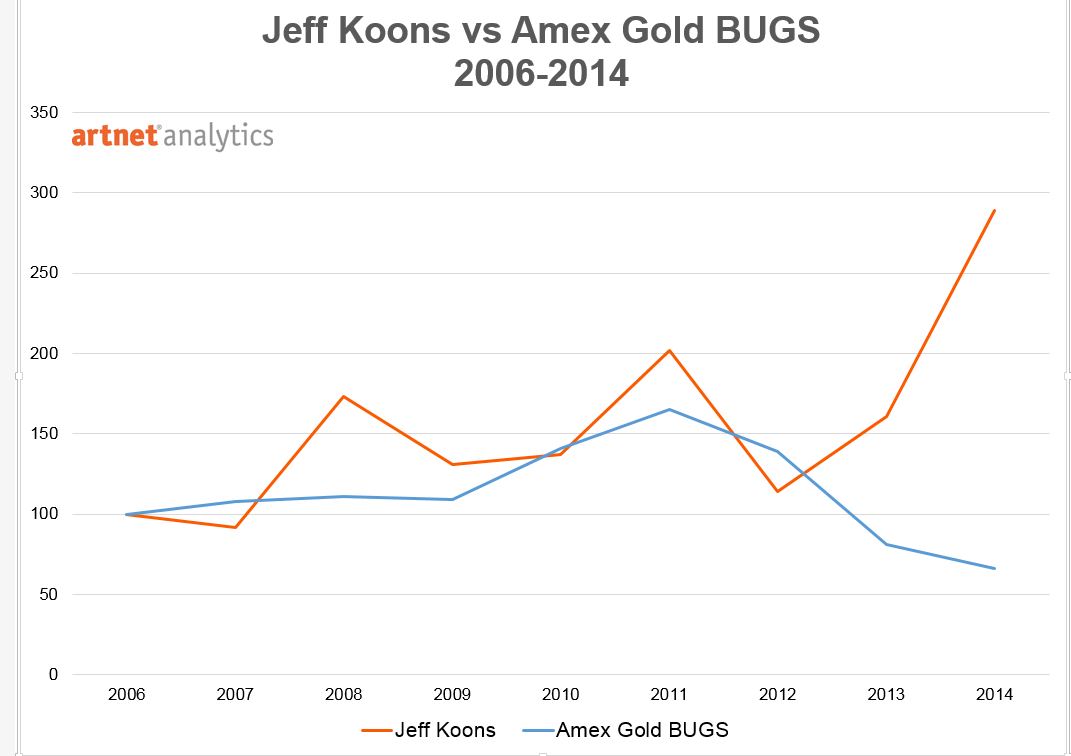
Koons’s auction price performance vs gold.
Source: artnet analytics
Though the Whitney show is understandably heavily weighted toward sculpture, there will also be a solid representation of paintings including pieces from the “Made in Heaven” series—sexually explicit pictures of Koons with his former wife, Italian porn star La Cicciolina; works from the “Luxury and Degradation” series (oil inks on canvas); giant, playful mashup paintings from the “Easyfun” series (which Loopy was a part of ); “Celebration” series paintings; and “Popeye” series paintings including Elvis, Olive Oyl, and Moustache Lobsters; and several “Antiquity” series paintings.
While Koons’s overall auction track record far outperforms the S&P, gold has given the Koons market a tougher run, as judged by performance of the kitschily-named Amex Gold BUGS Index (Basket of Unhedged Gold Stocks). Until recently that is (see charts above).
Follow Artnet News on Facebook:
Want to stay ahead of the art world? Subscribe to our newsletter to get the breaking news, eye-opening interviews, and incisive critical takes that drive the conversation forward.

